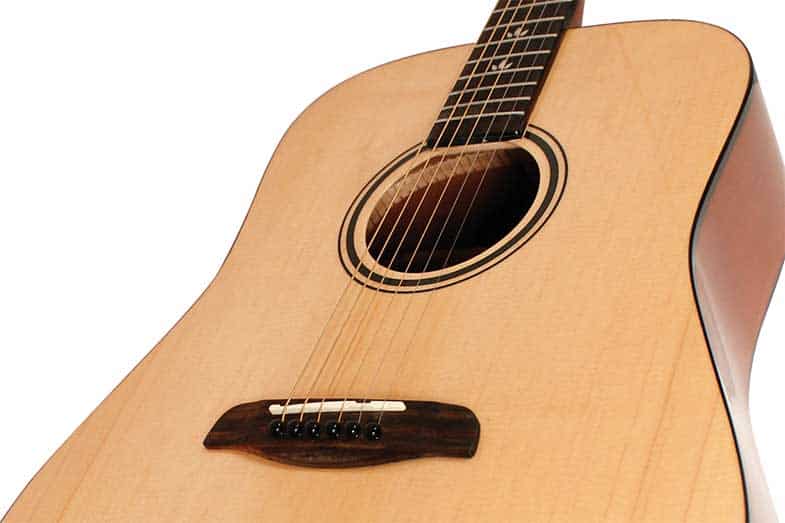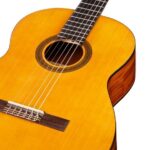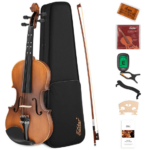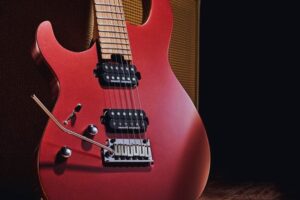There are many differences between an acoustic guitar and a bass guitar. By knowing the differences, you can decide which is the right instrument for you. What is the difference between an acoustic vs. bass guitar?
The typical acoustic guitar is an unplugged 6-stringed instrument with notes E-A-D-G-B-E. The typical electric bass guitar is a 4-stringed instrument with notes E-A-D-G (an octave lower than acoustic and regular electric guitars) and needs to be connected to an amplifier.
There are acoustic bass guitars available, but these aren’t as popular as the electric bass guitars as they simply aren’t loud enough to be heard in a band – unless an electric acoustic bass guitar is used.
If you are completely new to learning guitar, you might very well be confused about what guitar to get or what to start out on. Acoustic or bass? Which one should you pick? They are so similar in a lot of ways and yet completely different.
Read on to learn the significant differences between the acoustic and bass guitar so that you can choose which is best for you.
Also, for an excellent value acoustic guitar, take a look at the Donner 36” Dreadnought Acoustic Guitar Package. This is the perfect, affordable acoustic guitar kit for beginners:
Click here to see it on Amazon.
The Acoustic Guitar and Its Features
The acoustic guitar dates way back 4000 years ago. It is believed to have developed from the medieval instrument, the vihuela, which evolved from the ancient lute.
The first small, plucked guitars were called gitterns. They were created during the Spanish Middle Ages, with a round back, very similar to the lute. It was during the Renaissance era when modern guitar-shaped instruments started to be made, very similar to the guitars of today.
The typical acoustic guitar has six strings with a standard tuning of E-A-D-G-B-E. The exact notes for each string from lowest to highest are E2-A2-D3-G3-B3-E4. The numbers after each letter refer to the specific octave being played. There is a variation of acoustic guitar that has 12 strings, but the guitars with 6 strings are the more common ones.
The acoustic guitar is a fretted musical instrument that produces sound when the strings vibrate over a hollow chamber found in the body of the guitar. The vibrations then carry into the air.
Acoustic guitars do not use electrical amplification, but there are “electric acoustic guitars” available that you can connect to an amp. When performing on stage, a musician could place a microphone near the hollow opening of the acoustic guitar; or if they have an electric acoustic guitar, they just plug it into an amp.
The acoustic guitar has a neck, often made of maple wood, which is the long part from the headstock to the body. The top part of the guitar, called the headstock, has the tuning keys. The fretboard or fingerboard is mounted on the neck’s surface. The frets are embedded in the wood of the fingerboard at half-step increments. The frets indicate where different notes are played.
The body is often made of mahogany wood on the bottom (as it is a heavier wood) and spruce on the top (as it is a lighter wood). The body is composed of the soundboard and the sound-hole. The strings are mounted to the body and are anchored per string to the bridge pins.
The common acoustic guitar shapes have names: Range, Parlor, Grand Concert, Auditorium, Dreadnought, and Jumbo. The names are arranged from smallest to largest.
There are two kinds of acoustic guitars. They are nylon-string acoustic guitars and steel-string acoustic guitars.

Nylon String Acoustic Guitars
Guitars have been around since the 12th century. For a long time, strings for guitars and other string instruments were made with “catgut”. Catgut cord was from the walls of animal intestines, often sheep or cattle – not from cats. The term catgut may be short for ‘cattlegut’ or derived from the word kit, meaning fiddle.
As the guitar evolved, nylon replaced the catgut for the string. Nylon string acoustic guitars are commonly called classical guitars. They also can be called Spanish guitars. They have nylon strings that are fairly spaced apart so they have wide, flat necks. They have a strong resonance with a mellow tone. Due to their softer, lighter, mellower tone, they are commonly used for jazz, classical, or bossa nova music.
Nylon strings are flexible and are under less tension at pitch. This is why nylon string guitars have a mellow sound. They are most fitting but not limited to playing classical, flamenco, and folk music.
Playing the acoustic require without a strap requires you to be sitting. The ‘waist’ part of the guitar will rest comfortably and come down in a natural manner on your thighs.
If you want to play a nylon-string acoustic guitar, the Donner 36” Dreadnought Acoustic Guitar Package is the perfect, affordable kit for starting out.
Click here to see it on Amazon.
The kit comes with one of Donner’s most popular acoustic guitar models, along with several essential accessories, such as the hard-shell case, extra set of nylon strings, strap, tuner, and pick.
Steel String Acoustic Guitars
Steel-string acoustic guitars have a similar body construction as nylon-string guitars; however, they tend to vary more in size and shape. Steel-string guitars often have necks that are narrower and rounder. The thinner strings are made of string, and the thicker strings are either plated with nickel or made of pure nickel. They can be tough on your fingertips when you press the fretboard. Over time, the pads of your fingers strengthen, and it’ll be easier to press down on the steel strings.
The steel-string guitar is commonly played using a pick, and most of these guitars come with a pickguard. The pickguard is used to protect the guitar from being damaged by a pick. These guitars have a bright, crisp sound. They are most suitable for playing rock, country, or bluegrass tunes.
Note that you should not put steel strings on a nylon-string acoustic guitar, or vice versa; put nylon strings on a steel-string guitar. Nylon and steel strings are mounted differently. Nylon strings are tied around the bridge. Steel strings have ball-ends that are pulled against the bride by tension.
In theory, you could put nylon strings on a steel-string acoustic guitar, but if you put steel strings on a nylon-string acoustic guitar, the tension needed for the steel strings is more than the guitar is used to, and you could snap the neck.
Can You Use Electric Guitar Strings for Acoustic?
The Bass Guitar and Its Features
The first known electric bass guitar was invented in 1935 by musician Paul Tutmarc of Seattle, Washington. It was a fretted instrument designed to be played horizontally (the regular electric guitar was said to be invented a bit earlier, in 1931). Around 100 of Paul’s electric bass guitars were produced, but it wasn’t very successful.
In 1951, Leo Fender and George Fullerton developed the Precision Bass or P-bass. It was a bass instrument that was easier to carry. Up until the 1940s, the large upright bass was the main bass instrument used in music. So, when Fender and Fullerton mass-produced the smaller, electric bass, it became a popular choice for gigging musicians.
The standard electric bass guitar has four strings, but there are models that have five, six, seven, and eight strings. A four-string bass guitar’s strings are tuned to E-A-D-G. It is quite similar to the acoustic guitar except for the fact that it is tuned one whole octave lower in pitch. The exact octave notes on the bass are E1–A1–D2–G2. (Remember, 6-string acoustic guitar notes are E2-A2-D3-G3-B3-E4).

The bass guitar also has longer strings (and a longer neck, of course, for the longer strings) than an acoustic guitar or regular electric guitar. The longer a string is, the lower its frequency and pitch are. The bass guitar strings are also thicker and have looser tension than the acoustic guitar and regular electric guitars. This also contributes to the deep, long notes of the bass.
Bass guitars have basically the same parts as the acoustic guitar – body, neck, headstock, fingerboard, frets, and strings. They are, however, relatively larger and heavier than the acoustic guitar.
The bass guitar can come with frets or without frets. Fretless bass players rely on a trained ear and muscle memory. It is not for the beginner bassist.
One of the best entry-level bass guitars is the Yamaha TRBX Series Bass Guitar.
Click here to see it on Amazon.
This bass guitar has excellent tone, playability, and value. You can choose from the 100, 200, 300, 500, or the new 600 series. There’s also a large selection of colors to choose from. I’ve owned a Yamaha TRBX for many years, and it still delivers great sound, rivaling some of the more expensive brands.
For accessories, you will need a bass amp as well as a cord, strap, stand, and possibly travel case. There are some bass guitar kits online that bundle a bass with the amp, but I recommend getting the bass and amp separately as they are much better quality than the kits I’ve seen.
What is the difference between an acoustic guitar and a bass guitar? The typical acoustic guitar is an unplugged 6-stringed instrument with notes E-A-D-G-B-E. The typical electric bass guitar is a 4-stringed instrument with notes E-A-D-G (an octave lower than acoustic and regular electric guitars) and needs to be connected to an amplifier.
The Role of the Acoustic Guitar and the Bass Guitar
The acoustic guitar is quite versatile and comes with varied roles. Since it has a higher range, it can both be played supportive or solo. The acoustic guitar is often found in the spotlight because it is more versatile.
The bass guitar commonly plays a supportive role to set the foundation of the music. Imagine playing some music, and you find your feet tapping to the pulse – that’s usually the bass guitar you’re following. The bass guitar is like the pillar that supports and connects the other instruments being played. It is the ultimate connection between the rhythm and melody of a song.
If you look at bands, you will find that there are some that don’t have drummers or acoustic guitarists, but it is rare to find a band without a bassist. This shows that, although the bass guitar rarely goes solo, it is an essential part of the band.
The bass is nearly identical to the acoustic guitar, except for having 2 strings less and tuned to a lower pitch. But, basically, the chords, scales, and music theory you learn on one also apply to the other. So, if you actually choose to study either the acoustic or the bass guitar, in the end, you’ll be able to play the other. A direct correlation exists between the two.
Well-known Acoustic Guitar Players and Electric Bass Guitar Players
If you are keen on learning either the acoustic guitar or the electric bass guitar, it helps to find a well-known musician or two to mimic their style. There are so many well-known acoustic guitarists and bassists to choose from. Below, I’ll list some of the best. These aren’t the ones I consider best, but just some of the best – as there are simply too many to choose from!
Well-known Acoustic Guitar Players
Eric Clapton – English rock and blues singer, guitarist, and songwriter. Clapton is a three-time member of the Rock and Hall of Fame. He is amazing at both acoustic and electric guitar.
Phil Keaggy – American guitarist with 75 albums to his name and is undoubtedly one of the best acoustic guitarists of all time. He has contributed to recording in the mainstream market and Christian guitar playing.
Django Reinhardt – He is the founder of Gypsy Jazz, a certain style of Jazz that he started in Paris. His compositions include “Minor Swing” and “Djangology”. Several Django festivals are held annually throughout Europe and the U.S.
Tommy Emmanuel – An Australian guitarist, occasional songwriter, and singer known for his energetic performances. He is well-known for his amazing fingerstyle of plucking.
Well-known Electric Bass Guitar Players
Paul McCartney – The well-known singer and songwriter for The Beatles was not the original player for the band. He replaced the former bassist, Stuart Sutcliffe, and although, at first, he did not feel comfortable playing bass, he became one of the best bassists of all time. He is also a great solo performer.
Michael “Flea” Balzary – Flea is the famous bassist for the Red Hot Chili Peppers with three of his high school friends. Flea started out playing the trumpet but quickly learned the bass guitar. He is one of the most admired and visible rock bassists.
John Entwistle – Nicknamed “The Ox” and “Thunderfingers”, John is a founding member of The Who. He is among the few famous solo rock bass performers of all time.
Lemmy Kilmister – Lemmy is the bassist for the band Motorhead. He believed that attitude is just as important as talent. It is with this attitude that he became a legendary bassist and co-writer for other important artists like Ozzy Osbourne.
Victor Wooten – Victor is one of the most well-known bassists, recipient of 5 Grammy awards, recorder producer, and educator. He has been the bassist in several bands, from Bela Fleck, the Flecktones, SMV, and recently the metal band Nitro.
Conclusion – What is the Difference Between Acoustic and Bass Guitar?
The typical acoustic guitar has 6-strings (E-A-D-G-B-E) and is unplugged/acoustic. The typical electric bass guitar has 4-strings (E-A-D-G that is an octave lower than acoustic and regular electric guitars) and needs to be connected to an amplifier.
Whether you choose to master the acoustic or electric bass guitar, your success and progression will rely mostly on the quality and quantity of practice time you put in. Some naturally gifted and talented people can learn to play the guitar by themselves – these are the lucky ones. However, if you do not fall under that category, it is best to get some professional lessons. Choose the right instructor and/or a good music school.
Dedicate time to practice on a daily basis. It doesn’t have to be a rigid schedule. You just need to find time for it every day. Work one lesson at a time. Eventually, with enough practice, you won’t need to even look at the music sheet and will be able to play memorized songs.
There will also be some discomfort and pain at the start. But, believe me, no professional guitar player or bassist came to be where they are now without experiencing these too. Keep practicing, and you’ll get there. Once you learn one instrument, you will find it much easier to try the other, so in the future you can play both if you prefer.
Related reading:
Acoustic or Electric Bass for Beginners: Which is Better?
Best Way to Learn Guitar [12 Tips for Learning Acoustic or Electric Guitar]
Active vs Passive Bass Guitar: Which is Better?











